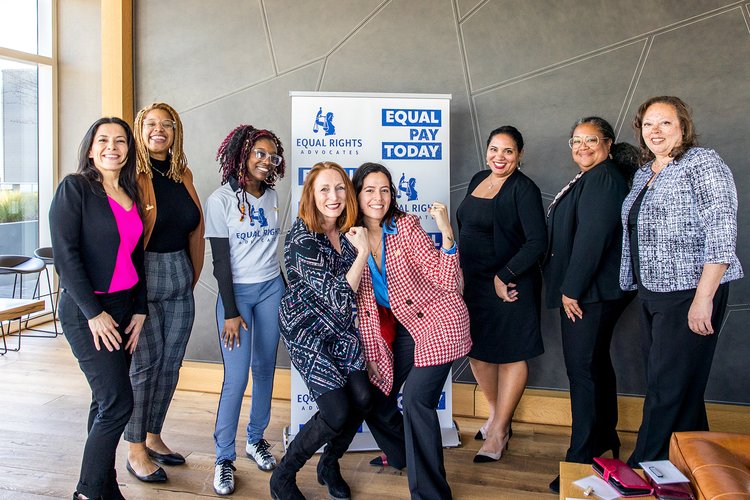

Equal Pay Day 2022
Join Equal Rights Advocates and our Equal Pay Today partners to raise awareness on Equal Pay Day 2022, March 15!
- Join the social media storm, from 11 a.m. – 12 p.m. Pacific / 2 p.m. – 3 p.m. Eastern. Raise awareness with us using hashtags #EqualPayDay and #EqualPayDay2022.
- Tune into the flashtalk: “A More Inclusive Equal Pay Day,” live on our Facebook page.
- Donate to support equal pay! All amounts make a difference and are welcome!
And from March 9 – March 15, raise awareness with us online with March Madness: Equal Pay Edition week of action and discussions! More information here.
What’s new this year?
With our Equal Pay Today partners, we’re putting forward new, more inclusive information that include income data for workers typically excluded from calculations—part-time, migrant, seasonal, and gig workers. For too long, these workers have been excluded from equal pay conversations, despite the fact that many of them work more than 40 hour/week because they have multiple part-time jobs just to keep a roof over their families’ heads.
34 million women are essential workers in this country, and they are disproportionately overrepresented in the lowest-paying essential fields, such as food service, retail, factory garment production, teaching, daycare and domestic work like nannying and caring for elderly or disabled people. By excluding some of our country’s hardest working and lowest paid women from equal pay conversations, it presented an inaccurate picture of how dire the situation is—especially for women of color. That changes now.
Why is Equal Pay Day March 15?
In 2021, the average U.S. woman was paid only 83 cents for every $1 paid to the average man. So based on that stat, Equal Pay Day is March 15, because it marks how far into 2022 the average U.S. woman had to work in order to catch up with what the average man earned in 2021.
How does it impact women?
Well, that means the average woman loses more than $10,000 every year to gender and racial pay discrimination. That’s 3 extra months of work. Or, if you’re looking at a typical 9-5 workday, that means women start working for free at 2:40 p.m.
To put this into perspective, if the gender wage gap were eliminated, the average woman would have enough additional money every year for:
-
- An entire additional year of child care;
- One year of tuition and fees for a 4-year public university, or the full cost of tuition and fees for a 2-year college;
- More than 9 months of rent for the following year;
- 7 months of health insurance (premiums through employer-based plans);
- More than a year’s worth of food; OR
- Enough money to pay off their student loan debt in under 4 years.
What about women of color?
For women of color, the wage gaps are much worse. The 83 cents / March 15 equal pay statistics are an average for all U.S. women. For individual demographics of women of color, the dates fall much later in the year:
-
- AANHPI women must work until May 3 to catch up with the average white man’s earnings from the year before, because they’re paid 75 cents per $1 paid to white men.
- For Black women, it’s Sept. 29, at 57 cents per $1.
- For Native and Indigenous women, it’s Dec. 1, at 50 cents.
- And Latinx women are paid the least, at 49 cents.
- We will recognize Latina Equal Pay Day on Dec. 8 this year, but Latina Equal Pay Day shouldn’t actually be recognized until 2023, since the average Latina is paid less than half of the average white man’s income. In other words, the average Latina woman would have to work 70 years to earn what the average white man earns over a typical 35-year career.
This is also true for Moms across race and ethnicities. The average mom has to work until July this year to catch up with what the average father earned by Dec. 31 last year.
Learn more at equalpaytoday.org
Stay Connected & Take Action
- Get the Latest News & Information Sign up for Email Updates
- Sign Up for Action Alerts Join the Action Team
- Follow Us


